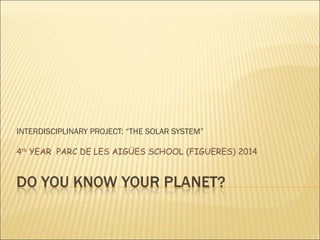Projecte interdisciplinari do you know your planet task3 4t
- 1. INTERDISCIPLINARY PROJECT: ŌĆ£THE SOLAR SYSTEMŌĆØ 4th YEAR PARC DE LES AIG├£ES SCHOOL (FIGUERES) 2014
- 2. ’āÆ Hello! ’āÆ My name is S├Łlvia Alonso Rud├│ and I am the teacher of the 4th year at the Parc de les Aig├╝es school in Figueres. ’āÆ IŌĆÖm a teacher of the ŌĆ£cicle mitj├ĀŌĆØ (3rd and 4th grade). I HOPE YOU LIKE THIS PROJECT!
- 3. ’āÆ Every year the students of cicle mitj├Ā participate in an interdisciplinary project. There are two projects : ŌĆ£Dal├ŁŌĆØ and ŌĆ£Solar SystemŌĆØ. ’āÆ This year we are working on the solar system. ’āÆ The teachers of my cycle realized, from the evaluations done in the last two years, that the students were very interested in the Earth and in the Moon, and there werenŌĆÖt enough sessions in the project to work on them in depth. ThatŌĆÖs why, and thanks to the GEP course, Caterina Ferrer and I decided to reorganise these two themes respectively.
- 4. ’āÆ Learning objectives: (content and language) ŌĆó To learn the contents related to the Earth seen in this didactic unit. ŌĆó To relate the contents related to the Earth with others seen in the project. ŌĆó To get the global meaning of the oral messages. ŌĆó To participate actively in the oral activities using the linguistic structures and vocabulary that appeared in the didactic unit and paying attention to the fluency and accuracy. ŌĆó To get the global meaning of the written messages. ŌĆó To participate actively in the written activities using correctly the linguistic structures and vocabulary that appeared in the didactic unit paying attention to the spelling and grammar: the Earth, the continents, the water, the air, the animals and the plants are...have.... There is/are ........ on the Earth. We are the...group. The parts of ...are... ŌĆó To use some web pages and informatics tools needed to develop the project (word, powerpoint, web sites: www.nasa.gov (nasakids clubhouse) www.pinterest.com, www.xtec.cat, www.slideshare.com). ŌĆó To contribute to the work carried out by the group .
- 5. ’āÆ Competencies involved: ŌĆó Communicative competence (linguistic and audiovisual) ŌĆó Artistic and cultural ŌĆó Digital competence ŌĆó Learn to learn ŌĆó Autonomy and personal initiative ŌĆó Knowledge and interaction with the physical world. ŌĆó Social competence ’āÆ Assessment: ŌĆó TeacherŌĆÖs rubric ŌĆó Individual rubric (students). ŌĆó Small group rubric (students).
- 6. ’āÆ WHO? This experience was carried out by the 4th year-students. ’āÆ WHEN? At the end of the first term during the Sciences, Artistic and Tutorial lessons. ’āÆ In some sessions, two teachers are needed.
- 7. SESSION 1. ACTIVITY 1. WE RECEIVED AN EMAIL FROM AN ALIEN SESSION 1. ACTIVITY 2. WE DID A SEARCH FOR INFORMATION ON THE NASA WEBSITE
- 8. SESSION 2. ACTIVITY 2. WE ARE LOOKING FOR IDEAS ON THE WEBSITE PINTEREST.COM SESSION 2. ACTIVITY 1. WE DECIDED IN GROUPS THE INDIVIDUAL ROLES OF EACH CHILD.
- 9. SESSION 3. CHILDREN LOOKING FOR IDEAS ON THE COMPUTER AND BEGIN TO CREATE THE PROJECT. SESSION 4. WORKING COOPERATIVELY
- 10. SESSION 5. PRESENTATION OF THE WORK CONTINENTS GROUP AIR GROUP
- 11. PLANTS GROUP ANIMALS GROUP
- 12. WATER GROUP FINAL TASK: PREPARING THE EXHIBITION
- 14. SESSION 6. ACTIVITY 1. INDIVIDUAL RUBRIC SESSION 6. ACTIVITY 2. SMALL GROUP RUBRIC
- 15. ’āÆ These are my personal conclusions after having implemented this project: Positive aspects ŌĆó The students became involved quickly in the working proposal. They were completely motivated and eager to do it very well.Working in collaborative groups is also very interesting. ŌĆó Students are not sufficiently accustomed to use ICT, they loved working with new resources. ŌĆó I believe that classes are more motivating and are more consistent, using digital resources . ’āÆ Negative aspects ŌĆó They have worked hard to speak, at all times in English, but they don't have enough vocabulary to do so with confidence and security. ŌĆó Students are not accustomed to working in a cooperative way, it was difficult for them to accept their roles.















